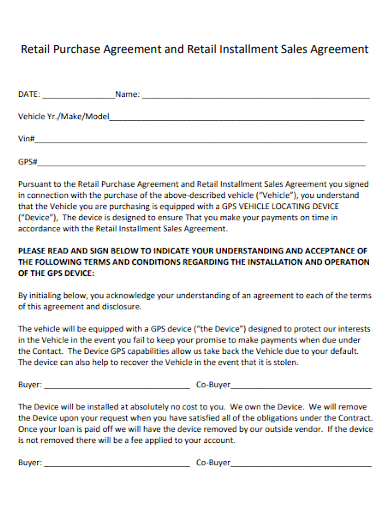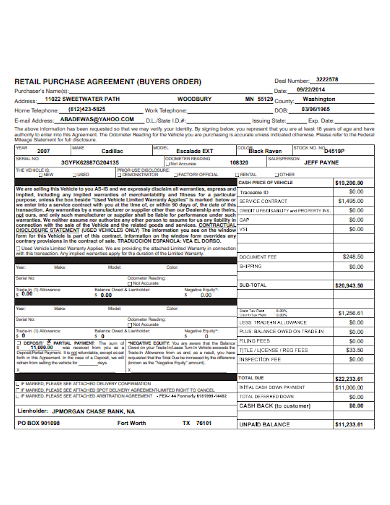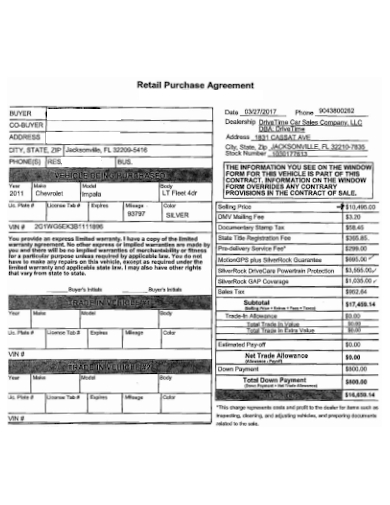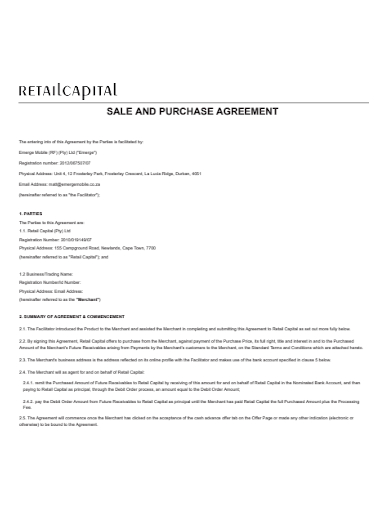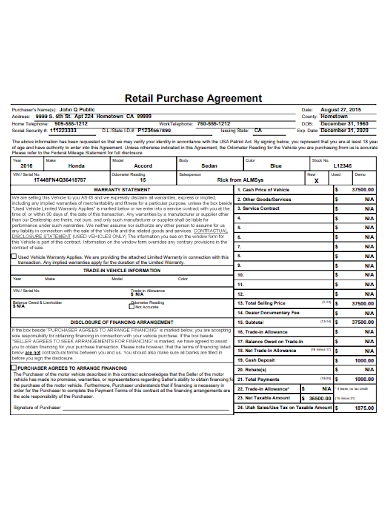The retail point of purchase is the point at which all of the components of a sale—the customer, the money, and the product—come together. The marketer seeks to influence the consumer’s buying choice by employing numerous communication vehicles at the point of purchase (POP), such as displays, packaging, sales promotions, in-store advertising, and salespeople.
5+ Retail Purchase Agreement Samples
It was now important to learn the where, who, what, when, and why of the consumer’s purchasing patterns and choices through research and study. The “where” refers to the geographical location from which the store draws clients. The “who” refers to the demographic descriptors of these clients, which are used to create a profile of potential customers. The “what” refers to the products that these potential customers desire to buy and, as a result, want the merchant to carry. When we say “when,” we’re referring to the time of year when customers make their purchases. The “why” relates to the psychographics of the clients, which reflect their various life styles and how these life styles are projected into purchase behaviors.
1. Retail Purchase Agreement Template
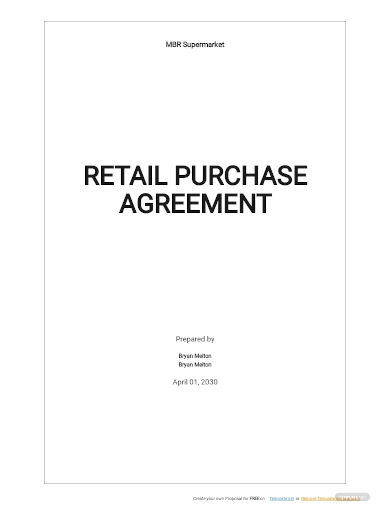
2. Retail Purchase and Installment Sales Agreement
3. Retail Purchase Agreement Buyers Order
4. Sample Retail Purchase Agreement
5. Retail Capital Sale & Purchase Agreement
6. Printable Retail Purchase Agreement
As a result of this consumerism, small retailers and buyers for larger stores have had to acquire the importance of a new lexicon in order to properly implement this item marketing strategy.
The Merchandise Plan
The approach applies to all types of retailing at all levels of sales. It’s usually a six-month merchandising plan, but depending on the product, it could be longer or shorter. February-March-April and May-June-July are the first six months of the plan. This strategy was created and finalized in August of the preceding year to allow for the purchase of imports and other products ahead of schedule. August-September-October and November-December-January make up the second six-month plan. For the same reasons indicated above, this strategy was drafted and finalized in February of the prior year.
The Stock Plan
The retailer separates the major categories into smaller categories called classifications after establishing the broad types of items the business will carry. Sub-classifications are then created from the classifications. The amount of items to be supplied in each category by price, style, color, and size is then determined by a unit stock plan. The goal of this strategy is to ensure that the stock contains a selection of things that will meet the wants and needs of a wide range of target customers. The model stock or basic stock list is one component of the stock plan approach. This list will include the things that the consumer expects to always have in stock.
The Buying Plan
One of the most crucial parts of market penetration is having things available when buyers want to buy them. This entails going to the store and purchasing the products early enough to assure timely delivery to the retailer. As a result, purchasing for a retail store necessitates planning ahead of time to identify the inventory requirements for each month and then making commitments without delay. Because stores begin selling new things months before the actual calendar date for the start of the new season, it is critical that purchasing plans be made ahead of time to allow for wise purchases rather than last-minute panic purchases.
The Selling Plan
The Selling Plan is intertwined with the Purchasing Plan. After the item has been purchased, strategies must be made to ensure that the maximum number of units are sold throughout the consumer acceptance period.
The Unit Control Plan
It is vital to develop an adequate form of control over the merchandise on order and the merchandise in stock in order to maintain an in-stock position of desired things and to dispose of undesired items. There are a variety of simple, low-cost unit control options available to small retailers.
FAQs
What is the new importance of point of purchase?
POP spending is becoming more important to marketers for three reasons. For starters, they are frequently more cost-effective than advertising and promotion. Second, the loss in store-level sales support is piqueing retailers’ interest in manufacturers’ POP campaigns. Third, changes in customer purchasing habits and expectations, as well as an increase in impulse purchases, mean that the point of purchase is now more crucial than ever in influencing consumer decisions.
In what aspect does POP focuses on?
POP programs are aimed at consumers, but they also serve the trade. POP expenditures are typically more productive than off-invoice price reductions to the trade, which risk being pocketed and hence withheld from the consumer, because they assist move products off the shelves and into customers’ hands.
If you want to see more samples and formats, check out some retail purchase agreement samples and templates provided in the article for your reference.
Related Posts
FREE 10+ Mentoring Agreement Samples In MS Word | Apple Pages | PDF
FREE 10+ Partner Agreement Samples In MS Word | Google Docs | Apple Pages | PDF
FREE 10+ Individual Agreement Samples In MS Word | Google Docs | Apple Pages | PDF
FREE 10+ Strategic Agreement Samples In MS Word | Google Docs | Apple Pages | PDF
FREE 10+ Equity Agreement Samples In MS Word | Google Docs | Apple Pages | PDF
FREE 10+ Producer Agreement Samples in MS Word | Apple Pages | PDF
FREE 10+ Grant Agreement Samples In MS Word | Apple Pages | PDF
FREE 8+ Meeting Agreement Samples in MS Word | Google Docs | Apple Pages | PDF
FREE 10+ Community Agreement Samples In MS Word | Google Docs | PDF
FREE 8+ Real Estate Option Agreement Samples in MS Word | PDF
FREE 10+ Call Option Agreement Samples In MS Word | PDF
FREE 10+ Advertising Agreement Samples In MS Word | Google Docs | Apple Pages | PDF
FREE 10+ Car Agreement Samples In MS Word | Google Docs | Apple Pages | PDF
FREE 10+ Horse Agreement Samples In MS Word | Apple Pages | PDF
FREE 10+ Option Agreement Samples In MS Word | Google Docs | Apple Pages | PDF

